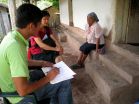(Press-News.org) This news release is available in French.
Montreal, May 6, 2015 -- Plans for summer holidays are already taking shape. But before jetting off for some fun in the sun, many travellers will have to cope with long delays on the airport runway.
Thanks to new research from Concordia University, however, that time spent twiddling your thumbs on the tarmac could be significantly reduced.
In a new study, forthcoming in the American Institute of Aeronautics and Astronautics' Journal of Aircraft, Concordia mechanical engineering professor Georgios Vatistas describes a new mathematical tool he developed to calculate the flow of turbulent air produced by a plane's wing tips -- known scientifically as wing-tip vortices -- when an airplane takes off.
"Every aircraft leaves in its wake a turbulent flow of air that can be dangerous to the airplane immediately behind it. That's why there are often large separation distances between planes as they line up for takeoff. It's a major cause of delays on the runway," says Vatistas, who is no stranger to vortex research. In 2008, he and his team became the first to physically validate Nobel Prize winner J.J. Thomson's then 125-year-old theory on the stability of vortex rings.
The study will assist in improving the present standards for the separation distance between planes, while maintaining safety.
Mathematically calculating the amount of turbulence created by the wing tips of aircraft, particularly during takeoff, gives air traffic controllers a better method of determining how far each aircraft should be from the next.
"This research will place the required separation distance on a better ground, particularly for the huge Airbus 380," says Vatistas.
"Our model takes the airplane's specifications into account to develop a more precise picture of exactly how strong the wing tip vortices are. From that, you can accurately calculate how far away the following aircraft needs to be for safety," says Vatistas, who partnered with Concordia Master of Applied Science (MASc) students Fani Maniki and Georgios Panagiotakakos, for the study.
Extending the "Vatistas Vortex Model" to account for turbulence, the research team carefully recreated the swirling vortices of air produced by the wing tips of aircraft during takeoff. This turbulent air is particularly dangerous when it comes to the wake created by heavy, wide-body aircrafts.
"To make takeoff procedures more efficient, we need to establish strict separation standards for new aircraft like the super-heavy Airbus 380, which are becoming more and more common on runways around the world. At the same time, we need to develop more precise standards for smaller aircraft. This mathematical model could guide us to do both -- in effect, tailoring separation distances based on aircraft size to allow better variability in spacing."
Vatistas expects that future studies using his research team's new methodology will improve on aviation safety by determining more precise safe-separation distances among different types of aircraft.
INFORMATION:
Partners in research: The study was partially funded by the principal investigator's NSERC discovery grant.
Related links:
Department of Mechanical and Industrial Engineering (MIE) https://www.concordia.ca/encs/mechanical-industrial.html
George Vatistas http://users.encs.concordia.ca/~vatistas/
The American Institute of Aeronautics and Astronautics (AIAA) https://www.aiaa.org/
Media contact:
Cléa Desjardins
Senior advisor, media relations
University Communications Services
Concordia University
Phone: 514-848-2424, ext. 5068
Email: clea.desjardins@concordia.ca
Web: http://www.concordia.ca/now/media-relations
Twitter: END
A Stirling scientist who discovered a new Scottish flower has made an unexpected second finding which provides unique insight into our understanding of evolution.
Dr Mario Vallejo-Marin, a Plant Evolutionary Biologist at the University of Stirling, first unearthed a new species of monkeyflower on the bank of a stream in South Lanarkshire, Southern Scotland in 2012.
A subsequent expedition two years later led Dr Vallejo-Marin to locate the impressive yellow flower some 350 miles north, near Stromness on the Orkney Islands off the north coast of Scotland.
"Orkney was ...
There are now over 80,000 apps marketed as "educational" in the Apple app store, the majority of which are targeted towards children and even babies. Parents are led to believe that these apps provide real learning opportunities for their children, but scientific research suggests that many of the apps are nothing more than digital candy.
"Many apps marketed as 'educational' are basically the equivalent of sugary foods," says Kathy Hirsh-Pasek of Temple University, co-author on a new report investigating educational apps. "At best, most of these apps will do no harm; ...
NEW YORK (May 6, 2015) -- To fence or not to fence? That is the question facing conservationists concerned with barriers that keep wildlife in and people out.
According to a new study by the Zoological Society of London (ZSL), Wildlife Conservation Society (WCS) and other groups, appearing in April 20 edition of the Journal of Applied Ecology, new policies must be developed before fences are erected - particularly in dryland ecosystems where mobility is essential for both humans and wildlife.
Some nations are considering fences as a means to protect remnant wildlife ...
This news release is available in German.
An X-ray study carried out at DESY allows to improve the quality of chocolate. The study offers new insights into the formation of fat bloom, an unwelcome white layer that occasionally forms on chocolate. "Although fat blooming is perfectly harmless, it causes millions in damage to the food industry as a result of rejects and customer complaints," explains the main author of the study, Svenja Reinke, from the Hamburg University of Technology (TUHH). "Despite this well known quality issue, comparatively little has been known ...
(BOSTON) - Increasingly, scientists across the world and in the Unites States are reporting new and groundbreaking innovations in biotechnology with transformative implications in human health and environmental sustainability. Examples range from synthetically created, metabolically-engineered bacteria for the sustainable production of fuel to gene editing therapies that could one day help in the prevention and treatment of a large number of human diseases.
While these technologies are developed in laboratories, researchers are not only giving utmost consideration to ...
New Haven, Conn. - Convincing a large group of people to change its behavior is no popularity contest, a new study shows.
In a novel experiment, researchers found that certain public health interventions work best when key "influencers" in a face-to-face social network are exposed to the program. What's surprising, they say, is that those key influencers are not the most socially connected people in the network.
Furthermore, those individuals can be identified through a survey method informed by network structure rather than costly and time-consuming social network mapping. ...
Maybe it's not such a dog-eat-dog world after all. A clever combination of two different types of computer simulations enabled a group of Illinois researchers to uncover an unexpectedly cooperative group dynamic: the spontaneous emergence of resource sharing among individuals in a community. Who were the members of this friendly, digitally represented collective? Escherichia coli, rod-shaped bacteria found in the digestive systems of humans and many other animals.
The finding, initially predicted by mathematical models and then confirmed through empirical testing, was ...
Chocolate is one of the world's most popular foods, but when a whitish coating called a bloom appears on the confection's surface, it can make consumers think twice about eating it. The coating is made up of fats and is edible, but it changes the chocolate's appearance and texture -- and not for the better. Now scientists report in the journal ACS Applied Materials & Interfaces new information that could help chocolatiers prevent blooms from forming.
Svenja K. Reinke and colleagues explain that baked goods and confectionery products, including chocolate, contain a mix ...
WASHINGTON, DC (May 6, 2015) -- Patients with a history of trauma can benefit from working with healthcare providers who understand trauma's role in health and can offer resources to assist with healing. A commentary published today in the journal Women's Health Issues proposes an approach to providing such trauma-informed primary care (TIPC). Edward L. Machtinger, MD, director of the Women's HIV Program (WHP) at the University of California, San Francisco, and his co-authors identify four core components of a TIPC approach: environment, screening, response, and a robust ...
Diagnosing a heart attack can require multiple tests using expensive equipment. But not everyone has access to such techniques, especially in remote or low-income areas. Now scientists have developed a simple, thermometer-like device that could help doctors diagnose heart attacks with minimal materials and cost. The report on their approach appears in the ACS journal Analytical Chemistry.
Sangmin Jeon and colleagues note that one way to tell whether someone has had a heart attack involves measuring the level of a protein called troponin in the person's blood. The protein's ...



